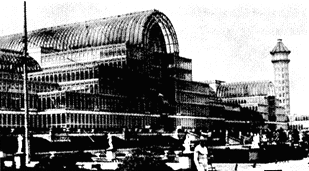
According to Bruce M. Coleman, Professor of Architecture, Syracuse University, this photograph shows "the rebuilt version of the building, reconstructed at Sydenham as a private commercial venture. Constructuion started in 1852 and finished in 1854 with many more parts, 50% more volume and double the glass area. Paxton and his partners officially named this structure The Crystal Palace. The original building was known as 'The Building for the Great Exhibition of 1851' and only nicknamed the Crystal Palace."
The Crystal Palace (1851-54), an enormous construction of iron and glass, seemed to many one of the great wonders of the modern world — and to others a monstrosity. although it seemed to offer the promise of a new era of iron and glass buildings, it had surprisingly little effect on architects and architecture. According to J. Mordaunt Crook,
The Crystal Palace (1851-4) seemed to lie outside the world of architecture, outside even the world of engineering. The criteria by which it might be judged still awaited formulation. In Hitchcock's words, Paxton's scheme "owed its aesthetic qualities to factors hitherto unrecognised — the repetition of units manufactured in series, the functional lace-like patterns of criss-cross trusses, the transparent definition of space, the total elimination of mass and the sense of tensile, almost live, strength as opposed to the solid and gravitational quality of previous masonry architecture." The vocabulary of a machine aesthetic had yet to be developed. 107
As architectural historians have long pointed out, it derived not from what architects considered architectural tradition but from greenhouses, for as Crook explains, "The Crystal Palace was really the climax of a long tradition of conservatory design: the hot-house at Kew Gardens (1844-8) by Turner and Burton being simply the best known example" (105). For this and several other reasons, therefore, this landmark, pioneering structure did not issue in an age of iron and glass architecture.
Bibliography
J. Mordaunt Crook. The Dilemma of Style: Architectural Ideas from the Picturesque to the Post-Modern. Chicago: University of Chicago Press, 1987.
Last modified December 2001